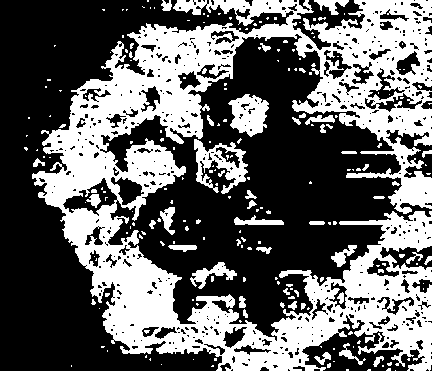A review I did of a Feigen show curated by Tim Griffin in 2000. Shortly after this was published Griffin moved to Artforum, and quickly became the editor. Sadly, two of the artists are now deceased, Susan Goldman and Jeremy Blake. In a nutshell, Griffin's show attempted to spice up some standard gallery fare with digital concepts and jargon but some of the work actually crossed the new media vs artists-with-computers divide in interesting ways.
"Compression," Feigen Contemporary, New York, NY, December 2, 2000 - January 12, 2001
(originally published in Art Papers, May/June 2001, p. 44)
This exhibition, curated by Tim Griffin, a founding editor of artbyte magazine (and currently art editor for Time Out New York), attempts to link the art and cyber-discourses by asking: "What kinds of depicted space do we encounter when digital materials enter the picture?" Even with the collapse of the dot-com economy, this is a timely inquiry, since our living environments, work habits, and media views of reality continue to be shaped by software engineers, and artists are well-equipped by training and temperament to look over their shoulders and ask--from a conceptual and design standpoint--exactly what the hell they're doing. Although Griffin included a range of high-, low-, and no-tech work that purportedly addressed the question, unfortunately too many of the pieces required theoretical uploads from his exhibition essay to be relevant.
Only two of the artists make direct, hands-on use of the computer. Conjuring post-human exercise videos, Asymptote Architecture's looping, slowly morphing pod-shapes on small display screens combine machine curves, body contours, and textures scanned from athletic apparel. In Jeremy Blake's DVD light-show-in-a-box, pulsating color field patterns alternate with views of a synthetic Mediterranean villa, as if to say that inside the computer, it's all just planes and colors. Both artists favor the sleek airbrushed look typical of commercial digital work and display their pieces on pricy appliances such as wall-mounted plasma screens and Apple G-4 hard-drives; this is fine, but the danger of embracing the dominant economy's techno-fetish is that (as Joseph Kosuth once said of painting) one also embraces "the tradition that comes with it": consumption, fascination, waste.
Stephen Hendee bridges virtual space and gallery space without succumbing to cliches about the state of the art. His work might be called "proactively dated": using Foamcor, electrician's tape, and colored lights he creates walk-in environments recalling the faceted, wireframe landscapes in Steven Lisberger's retro-futurist (and still seductive) movie Tron (1982). Hendee's installation in "Compression" resembled a digital Fort Knox, with stacks of cartoon SIMMs (Single In-line Memory Modules) in place of gold bars--a fitting symbol for the (old) New Economy. Alternatively, the room full of boxes could be a kind of architectural history simulation, futuristically representing the not-so-futuristic storage warehouses that dominated West Chelsea before galleries and dot-commers came along.
Susan Goldman also practices reverse engineering, making handmade models--in her case 2-D--based on digital originals. Although her quirky arrangements of typography, pictograms, and clip-art look very "cyber," she draws and paints them entirely by hand on canvases or sheets of vellum. Her decentralized compositions and scatterings of fonts recall CD covers and club flyers from the rave underground, where graphic artists like Designers Republic and Switzerland's Buro Destruct challenge the fetishistic clarity of conventional illustration with semi-private, "wild style" languages. Unfortunately Goldman adds little to this oeuvre by hand-rendering it--the thin, spidery line she uses to enclose and define every form quickly becomes monotonous.
Which leaves three artists whose work, however compelling, had nothing inherently to do with digital space. Michelle Grabner coated two adjacent walls with white flocking and sprayed it with an infinitely subtle rainbow of pastel colors. This shimmering dematerialization of a gallery corner could be called "de-rezzed" if one wanted to give it a cyber-spin but could just as easily be about subverting the white cube with happy, fuzzy crafts. Dike Blair's elegant Zen gardens of display paraphernalia and slick home furnishings from outlets like IKEA and Home Depot could relate to "flagship stores" and other (digitally?) designed environments, as Griffin suggests, except that, by arranging these materials incongruously and applying photos to their smooth surfaces, Blair seems more interested in de-contextualization than "branding." Last, Diti Almog's paintings of nested, Albersian rectangles are all about the grid and "windows," and so is the computer, but so what?

